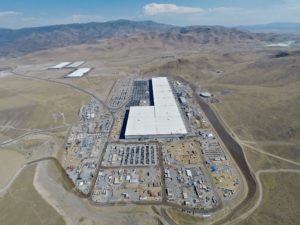A Manhattan Institute report has caused a re-examination of the greatest challenge in the move toward renewable energy. Author Mark Mills asks a simple question: what do we do when the wind doesn’t blow and the sun doesn’t shine?
Most westerners give it little thought. After all, the Sun itself is the iconic logo of New Mexico, and the wind never stops in Kansas. That over-simplified impression has led an entire generation down the path toward renewables, and politicians now promise 100 percent renewable power. This report prescribes a dose of realism, because the sun does not shine at night, even in New Mexico. So, the greatest challenge for renewables is – and has always been – storage. Giant batteries must be part of the equation. The only alternative is to maintain, switching on-and-off, all the existing power plants. And according to the report, those giant batteries, for which we gamble on future improvements in technology, are not forthcoming.
Most wind and solar facilities produce electricity only about a fourth of the time, so we just need large modern batteries like the ones Tesla is producing. Except for one detail – they are not even close to supplying enough storage capacity to make a dent.
The report, called “The New Energy Economy: An Exercise in Magical Thinking,” begins with the economics of battery storage. It costs less than a dollar a barrel to store oil for two months, but over $200 to store the same volume of energy in a grid-scale battery. Further, enough batteries to store the same amount of energy as that barrel of oil cost $200,000, and weigh over 20,000 pounds. The barrel of oil weighs 300 pounds, and costs $58.
 The size and cost of batteries is not the biggest issue in the report, though. It is the lack of capacity. Apparently, Tesla spent almost $5 billion building the largest battery factory in the world, the “Giga-factory” in Nevada. Yet the plant’s entire output could only store three minutes’ worth of U.S. electrical demand. The report says 1,000 years of that factory’s current output could provide storage for about two days of America’s electrical use. Mills concludes, “The issue with wind and solar power comes down to a simple point: their usefulness is impractical on a national scale as a major or primary fuel source for generating electricity.”
The size and cost of batteries is not the biggest issue in the report, though. It is the lack of capacity. Apparently, Tesla spent almost $5 billion building the largest battery factory in the world, the “Giga-factory” in Nevada. Yet the plant’s entire output could only store three minutes’ worth of U.S. electrical demand. The report says 1,000 years of that factory’s current output could provide storage for about two days of America’s electrical use. Mills concludes, “The issue with wind and solar power comes down to a simple point: their usefulness is impractical on a national scale as a major or primary fuel source for generating electricity.”
Do not despair, though. We have already met the 100 percent renewable goal. That’s because all energy is renewable, since the Sun is the source of all energy. Besides the direct solar energy hitting the Earth (enough arrives every minute to meet the entire planet’s demands for a year), the Sun warms the air, causes wind, melts snow, and makes rivers. Also, the Sun creates fossil fuels, just as continuously. The very concept of “renewable” and “non-renewable” is misleading – all resources are renewed; some just take longer than others. A tree can grow in less than a human lifetime, where coal and oil take a few thousand years. It is arrogance that we view resources as renewable only if we can see them renewed, or if we can “use” without “consuming” them. The greatest of the “renewable” resources in that sense are air, sunlight and water. When we generate energy from the wind or solar, the wind still blows and the Sun still shines. When we generate energy from moving water, water still flows to the oceans, evaporates and falls back on land. Because we can see those processes in our time, we consider that energy “renewable.”
On the other hand, when we burn coal, oil and gas, they seem gone forever. But of course, they are not. The carbon they emit helps grow plants, which continue to die and decompose into the ground, where heat and pressure eventually turn them into more coal, oil and gas. Because that takes longer than we can watch, we call those resources “non-renewable,” though the entire Earth is a giant fireball of energy, which we simple use and reuse.
New energy sources are continuously developed as they are needed, as the market demands. That is the way the economy works, and no government can amend the law of supply and demand. There are good and bad aspects of any business, so the debate rages on. But the future is not as depressing as some people think. A healthy and prosperous modern society requires energy to thrive. It can be supplied responsibly or irresponsibly – but healthy, prosperous, and free people will get it done.
This column first appeared in the Grand Junction Daily Sentinel September 27, 2019.




Comments on this entry are closed.